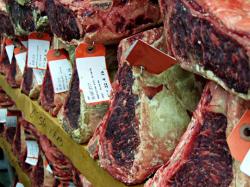Dry Vs. Wet: A Butcher’s Guide To Aging Meat
April 9, 2010 | 1 min to read

Dry-aged beef is one of those things that really get our customers excited
whenever we give tours of our meat locker. They marvel at the long row of rib
and drop loins along the top of the cooler racks, oohing and ahhing at their
individual farm tags and even petting the soft snow of mold silently changing
the beef from good to great.
Of course, dry aging, far from being the exotic ritual we make it out to be
today, is what pretty much all beef that wasn’t cured or canned used to be 30
years ago. What happened? Why is properly hung beef such an oddity today if it
was the industry standard such a short time ago? Plastic bags, unfortunately,
are the anti-climactic answer. Basically, the meatpacking industry figured out
that if you stick a piece of meat in a vacuum-sealed bag it not only reduces the
amount of money that is lost in water weight and trim but it also “ages” faster.
Thus the age-old Wet vs. Dry Aging Controversy began.
Okay, so what is aging and what are the differences between wet and dry aging
exactly? Aging is the process during which microbes and enzymes act upon the
meat to help break down the connective tissue, for the sake of making the
aforementioned meat object more tender. Whether it happens in a bag or out in
the air as a big swinging side of beef, that element of the process is the same
(okay, almost the same).
To read the rest of this story please go to:
The Atlantic
